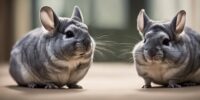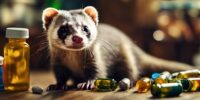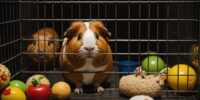Why Do Some Chinchillas Have Curlier Whiskers Than Others?
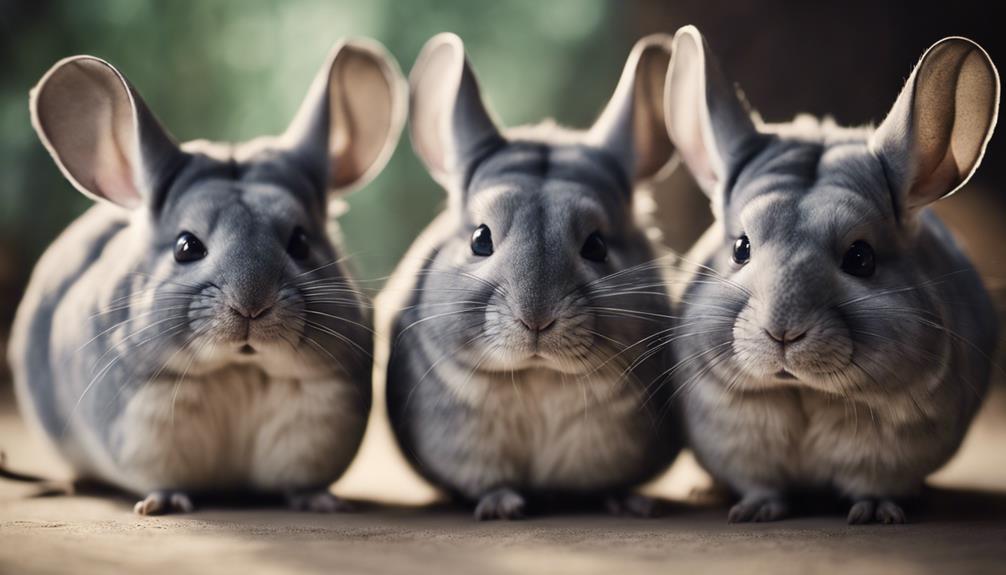
Chinchillas' whiskers play a vital role in sensing their surroundings, helping them navigate their environment. They are highly sensitive tactile hairs that help chinchillas detect objects, obstacles, and even changes in air currents.
The genetic variations in chinchillas can influence the texture and curliness of their whiskers. Additionally, environmental factors such as humidity levels and grooming habits can also affect the appearance and condition of a chinchilla's whiskers.
Chinchilla Whisker Structure Explained
Chinchilla whiskers, also known as vibrissae, are highly specialized tactile hairs that play a crucial role in the chinchilla's sensory perception. Whisker growth in chinchillas is a dynamic process that starts early in life and continues throughout their lifespan. These vibrissae are significantly longer and stiffer than their fur, aiding chinchillas in navigating their surroundings and detecting potential threats, such as predators.
Grooming techniques are essential for chinchillas to maintain the integrity of their whiskers. Chinchillas are meticulous groomers, using their front paws to clean and straighten their whiskers regularly. This behavior not only keeps their whiskers free from debris but also helps in maintaining the sensitivity of these specialized hairs. By grooming their whiskers, chinchillas ensure that they can effectively sense changes in their environment, enhancing their ability to survive in the wild. Understanding the importance of whisker care is crucial for chinchilla owners to promote the well-being of their furry companions.
Factors Influencing Whisker Curliness

Chinchilla whisker curliness is influenced by a combination of genetic factors, environmental conditions, and grooming habits.
Genetic influences play a significant role in determining the curliness of chinchilla whiskers, with certain genes predisposing them to be more or less curly.
Additionally, environmental factors such as humidity and temperature can impact the degree of curliness exhibited by chinchilla whiskers.
Genetic Influences on Curliness
The curliness of chinchilla whiskers is primarily influenced by genetic factors that determine the structural composition of the hair follicles. Curly whisker inheritance is governed by specific genetic mutations that affect the shape and texture of the whiskers.
Through selective breeding strategies, chinchilla breeders can intentionally propagate genes responsible for the desired level of whisker curliness. By identifying and pairing chinchillas with the desired curly whisker traits, breeders can increase the likelihood of offspring inheriting these characteristics.
Genetic studies have shown that certain genes play a crucial role in determining whisker curliness, highlighting the complex interplay between genetics and phenotypic traits. Understanding these genetic influences can help breeders enhance specific traits in chinchillas through informed breeding practices.
Environmental Impact on Curliness
Genetic mutations influencing whisker curliness in chinchillas often interact with environmental factors that can further shape the ultimate expression of this trait. When considering the environmental impact on whisker curliness, climate effects and diet impact play significant roles.
- Climate Effects: Chinchillas living in humid environments may experience changes in whisker curliness compared to those in drier climates due to the moisture levels affecting the hair texture.
- Diet Impact: A well-balanced diet rich in essential nutrients can promote healthy hair growth, potentially influencing the curliness of a chinchilla's whiskers.
- Environmental Stressors: Exposure to environmental stressors like pollution or extreme temperatures could also impact the curliness of chinchilla whiskers.
Grooming Habits and Curliness
One crucial factor influencing the curliness of chinchilla whiskers is their grooming habits, which can significantly impact the overall appearance and texture of the fur. Proper whisker care plays a vital role in maintaining healthy curl patterns. Chinchillas that receive regular grooming and styling techniques tend to have more defined and structured curls in their whiskers.
In contrast, chinchillas with neglected or irregular grooming routines may exhibit less uniform curl patterns. It's essential to consider the significance of whisker health when it comes to grooming practices. By incorporating appropriate styling techniques and consistent grooming habits, chinchilla owners can help enhance the natural curliness of their pets' whiskers, contributing to their overall well-being and aesthetic appeal.
The Role of Genetics in Whisker Variation

Recent advances in genetic research have shed light on the intricate mechanisms underlying the variation in chinchilla whiskers. The role of genetics in whisker variation can be fascinating and complex. Here are three key points to consider:
- Genetic Variations: Chinchilla whisker appearance is influenced by genetic variations passed down from parents to offspring. These variations can determine the curliness, length, and thickness of the whiskers.
- Evolutionary Advantages: Certain genetic traits related to whisker appearance may provide evolutionary advantages to chinchillas. For example, curly whiskers could enhance the chinchilla's ability to detect subtle changes in their environment, aiding in navigation and predator detection.
- Selective Breeding: Through selective breeding, chinchilla breeders can manipulate genetic factors to produce offspring with specific whisker characteristics. This practice has been instrumental in creating chinchillas with desirable traits for showmanship or research purposes.
Understanding the genetic basis of whisker variation in chinchillas opens up a world of possibilities for further research and appreciation of these adorable creatures.
Environmental Influences on Whisker Appearance
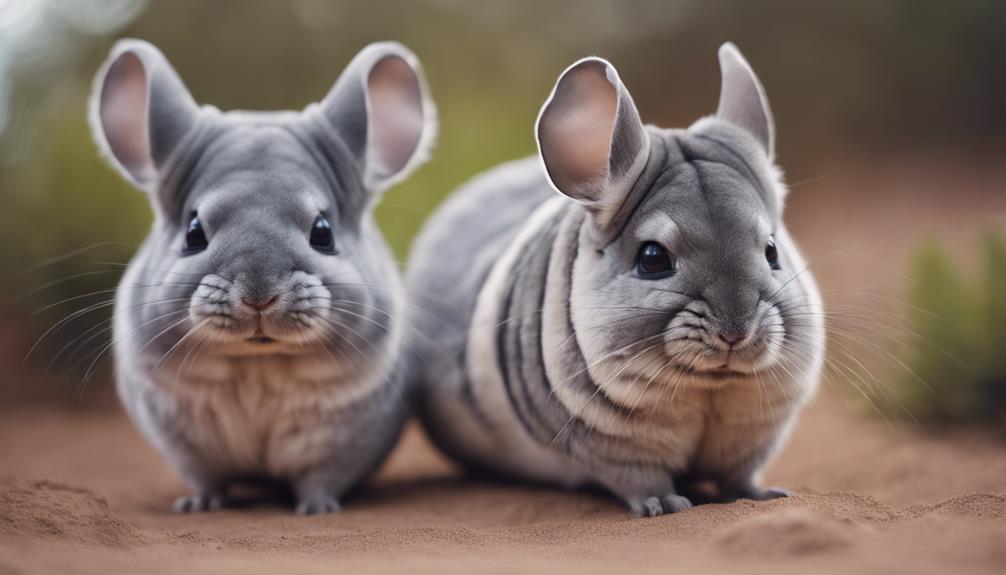
The environmental conditions in which chinchillas are raised play a significant role in shaping the appearance of their whiskers. Environmental factors such as temperature, humidity, and overall living conditions can impact whisker growth and texture. Chinchillas living in colder climates may develop thicker and more rigid whiskers as a way to adapt to the harsh conditions. On the other hand, chinchillas in warmer environments might've softer and more flexible whiskers.
Exposure to sunlight is another important environmental factor that can influence whisker appearance. Sunlight provides essential vitamins for overall health, including the health of whiskers. Chinchillas that have access to natural sunlight tend to have stronger and shinier whiskers compared to those kept in dimly lit environments.
Furthermore, the quality of the chinchilla's diet, which is influenced by its environment, can also affect whisker growth. A balanced diet rich in essential nutrients supports healthy hair follicles and can contribute to the overall appearance of the chinchilla's whiskers.
Nutritional Impact on Whisker Development

Nutrients obtained through a chinchilla's diet play a crucial role in the development and maintenance of their whiskers. The nutritional balance in a chinchilla's diet affects their whisker growth patterns significantly.
- Protein Intake: Chinchillas require a diet rich in high-quality proteins to support the growth of healthy whiskers. Proteins are essential for the development of keratin, the primary structural component of whiskers.
- Vitamin and Mineral Supplementation: Adequate levels of vitamins and minerals, such as vitamin A, biotin, and zinc, are essential for overall skin and hair health in chinchillas. Deficiencies in these nutrients can lead to poor whisker quality and growth.
- Omega-3 Fatty Acids: Incorporating sources of omega-3 fatty acids into a chinchilla's diet can promote healthy hair follicles and improve the overall condition of their whiskers. These fatty acids contribute to the development of strong and lustrous whiskers, enhancing their appearance.
Grooming Habits and Whisker Maintenance

Grooming habits play a crucial role in the maintenance of chinchilla whiskers, ensuring their health and appearance remain optimal. Regular grooming not only keeps the whiskers clean but also helps prevent tangles and matting, which can lead to discomfort for the chinchilla. Whisker trimming should be approached with caution, as these specialized sensory hairs are essential for the chinchilla's navigation and communication.
When it comes to grooming techniques, chinchilla owners should use gentle brushes specifically designed for small animals to prevent damage to the whiskers. Regular brushing helps distribute natural oils along the length of the whiskers, keeping them healthy and shiny. Avoid using harsh chemicals or excessive force during grooming, as this can lead to breakage or thinning of the whiskers.
Proper grooming habits not only contribute to the overall well-being of the chinchilla but also play a significant role in maintaining the integrity and functionality of their whiskers. By incorporating gentle grooming practices into their routine, owners can help ensure that their chinchilla's whiskers remain in top condition.
Curly Vs. Straight Whiskers: Aesthetic Preferences

Chinchilla whiskers come in varying textures, with some displaying a curly configuration while others maintain a straight structure, eliciting diverse aesthetic preferences among chinchilla enthusiasts. When it comes to whisker styling trends, chinchilla owners often find themselves debating the merits of curly versus straight whiskers. Here are some key points to consider:
- Aesthetic Debates: Some argue that curly whiskers give chinchillas a more playful and endearing look, adding charm to their overall appearance.
- Cultural Preferences: In certain cultures, straight whiskers are considered a sign of elegance and grace in chinchillas, leading to a preference for this sleeker style.
- Grooming Techniques: Maintaining curly whiskers may require more effort in grooming to prevent tangling, while straight whiskers are often easier to manage and keep neat.
Ultimately, whether one prefers curly or straight chinchilla whiskers boils down to individual taste, cultural influences, and the dedication to grooming routines.
Frequently Asked Questions
Like a compass in a stormy sea, chinchillas with curly whiskers may navigate as effectively as their straight-whiskered counterparts. Whisker functionality remains crucial for both, with genetics playing a role in the variation.
Are There Any Health Implications Associated With Chinchillas Having Curly Whiskers Versus Straight Whiskers?
Genetic variations in chinchillas can lead to curly whiskers, impacting their sensory function. However, there aren't specific health implications tied to whisker curliness. Chinchillas with curly whiskers can still effectively navigate and detect their surroundings.
Do Chinchillas With Curly Whiskers Require Different Grooming Techniques Compared to Those With Straight Whiskers?
Chinchillas with curly whiskers may need different grooming techniques than those with straight ones. Their unique whisker behavior requires specialized care techniques to maintain functionality. Understanding these distinctions is crucial for optimal chinchilla well-being.
Are There Any Specific Chinchilla Breeds or Species That Are More Likely to Have Curly Whiskers?
Chinchilla genetics play a role in whisker variations. Certain chinchilla breeds or species, like the Royal Persian Angora, are more likely to have curly whiskers due to genetic factors. Whisker curliness can be an inherited trait.
Can Chinchillas With Curly Whiskers Interbreed With Those With Straight Whiskers, and if So, What Impact Does This Have on Their Offspring's Whisker Appearance?
When chinchillas with curly whiskers interbreed with those having straight ones, genetic inheritance plays a crucial role. Offspring may exhibit a mix of whisker appearances due to evolutionary advantages and adaptations, showcasing the beauty of natural diversity.



